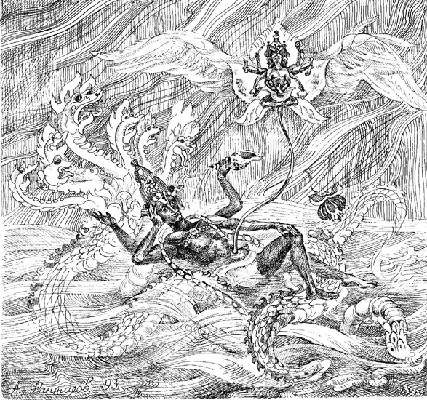|
|
|
Hindu myths 1.
1. In all a phenomenological variety of mythological images of Indo-European pantheons it is possible to isolate the invariant base types, making initial structural nucleus, each of which has one of five functions selected by the author. So, legislative function the God of the Clear Sky as he patronises breeding collective and the military right. By military - power function it is characterised the God of the Thunder being the spokesman of ideology of aristocracy among which priority interests military activity was took the major place. The god of Earthly Forces esteemed by priests and farmers, carries out agrarian - magic function (to him there is in agreement with the god of growth and in any measure the god of the earth Holan, and also Celt Cernunnos). The cultural Hero has got cultural-mediator function as he personifies sacred imperial authority, including role of the intermediary between gods and people (the god benefactor according to Holan, Smertrius in Hatt's concept). At last, the multifunctional syncretic female type of the Great Goddess connects a dual Sky-Earthly nature.
2. The circuit of mutual relation between these types can be presented as a ring, which is, formed by the man's characters, located beside with each other depending on correlation their functions. So, the God of the Thunder and the God of Sky in a number of traditions tend to merge in a uniform image as both they are connected to heavenly elements. The same tendency is observed and with reference to Earthly gods - to the God of Earth Powers and the Cultural Hero (though last can be the son of the first). Thus, the Cultural Hero as closely connected with the world of people the character, has the related features and good luck the Clear Sky (and in some traditions it is considered his son, between them also frequently arises intermediate type of twins. Only the God of the Thunder and the God of Earth Powers are antagonists (the Cultural Hero suffers from their conflict also). The unique female deity mentally placed in the centre of a ring, plays binding role among man's images. More often she of the spouse of the God of Thunder and the God of Earth Powers, in a number of traditions the goddess consists in marriage relations good luck the Clear Sky. And more and more late female characters of mythologies of Barbarous Europe (and the Indo-European mythologies as a whole) are derivatives from an image of the Great Goddess.
There are a similar characters in Indian mythology. Indra, The God of Thunder and Dyaus, The Sky God existed separately. The whole image character of The Great Goddess have not remained, although Kali Durga and Prthivi discented from her. The possessor of natural power Rudra was The God of Earth Powers. One of Rudra's ephithets is Pasupati, "the master of cattle". Possibly, this character originated from representations on the sighns of Indus civilisation. The divinity supported with animals on this sign and resembls Celtic Cernunnos. Then Rudra became one of the great medieval god Civa's names. But there was another related character in Veda. In a wellknown myth Indra and his dog Sarama (dog again!) set free heaven cows and defeated Vala, who concealed the cows in a cave. (It is interesting, that according to a Greek myth, Hermes also stole the cows).
As for The Cultural Hero, Manu and Yama - the sons of Vivasvat are quite suitable for this role. Manu was reputed as the progenitor and the ruler of mankind. In terms of the same tradition Yama was the first dead man and the ruler of ancestors. In ancient Iran these two divinities merged into an united character. This is Yima, a legendary king of the Golden Age. (His prototype is the first man and the master of the first bull. According to Russian scholars V. Ivanov and V. Toporov, Scandinavian giant Ymir with his cow Audumla and also Imra - a demiurge of the relict Aryan pagans of Hindu Kush associate with this theme).
A. Fantalov.

"Vishnu's mystery." (A. Fantalov, the image in Indian ink).
According to Hindu religion Vishnu is sleeping on the World Serpent Cesa. A flower, what is groing from Vishnu's navel, is opening and we see Brahma (god-creator of Indian myths).
Hindu myths 2. Menu